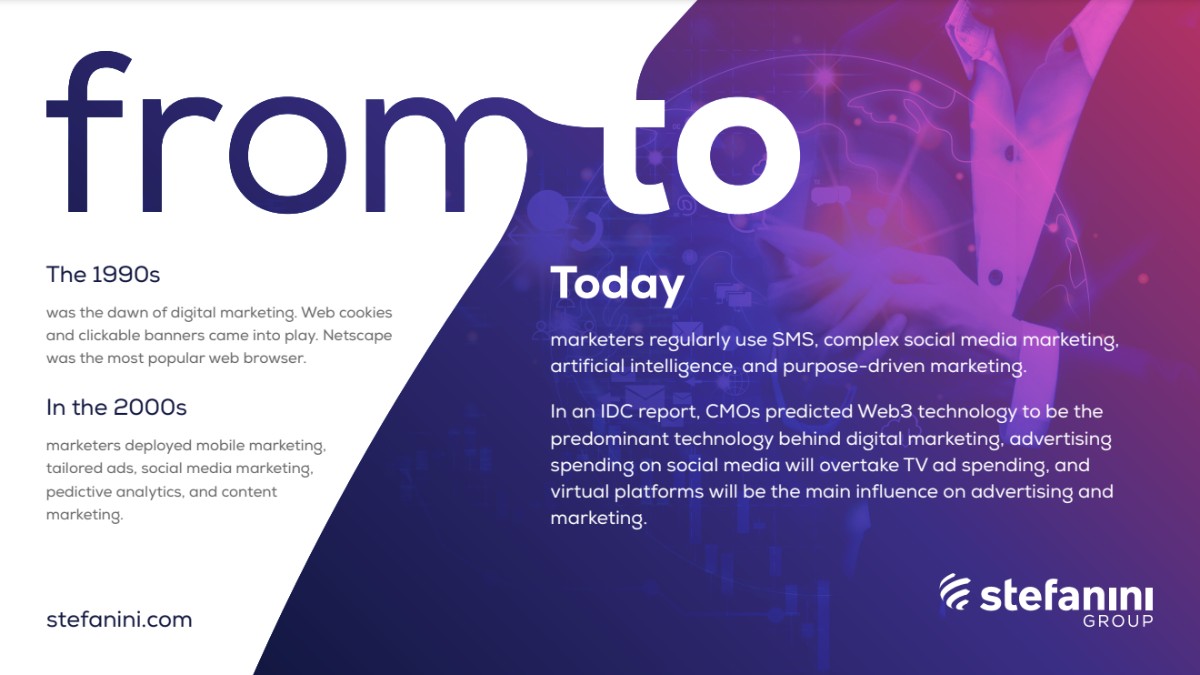Digital marketing technology and ideas evolve with global change. World change brings unique and exciting opportunities for brands to connect with their customers. When social, economic and political environments change, international marketers are already preparing themselves for leaner budgets in 2023.
By now, we know that change is the dominant fact of business life today. Chief executives face a perplexing predicament. Change is expensive, yet not changing costs more. The ability to master and capitalize on change are high-value management skills. Also, we expect to see more of an overlap among trends, specifically across customer-centricity, personalized marketing, customer experience, artificial intelligence and machine learning.
Global CMO 2023 Predictions

According to IDC FutureScapeTM, the digital-first business flipped to an all-digital business. Marketers at the leading edge of digital transformation initiatives know customers have shifted to digital-first and digital-always. This leads to a spending threshold, with most enterprise marketing budgets focused on digital programming.
Customers now get most of their information from emerging digital, interactive and video-based content. B2B and B2C customers want immersive brand experiences and to make purchases digitally.
In the FutureScapeTM report, marketing leaders should expect the world to go from digital to experiential.
Here are the top 10 trends identified by IDC:
- Web3 technology is expected to drive 45% of global brands, creating engaged communities and growing the customer experience (CX) creator economy into a $300 billion market by 2024.
- Customer data platforms (CDPs) will likely evolve into enterprise customer data services. By 2024, data streams and AI will improve interactions and CX metrics by 10% for 55% of G2000 firms.
- Google Advertising ID (GAID) will deprecate by 2025, reducing the total share of Android-based advertising by 10 points, benefitting iOS-based advertising, Apple and Amazon.
- G2000 brands must be transparent about and base marketing messages on “contextual value outcomes for the consumer.” Failure to do so could cause brands to lose up to 65% of lead-to-opportunity conversions.
- Expect 48% of G2000 B2B-branded content to be immersive, interactive and designed to meet consumers’ expectations set by B2C brands.
- Global advertising spending on traditional TV will likely plummet by 20% from $166 billion to $133 billion annually by 2025, directly impacting mobile video and CTV.
- By 2026, expect social media, community and virtual platform engagement to influence over 68% of brand revenue.
- By 2027, demands on performance and personalization, staffing limitations and mature technology is expected to result in “34% of content marketing programs” being managed autonomously through AI.
- Expect 68% of G2000 marketing organizations to employ AI for a mix of digital and human-delivered customer experiences throughout the customer journey.
- By 2028, G500 marketing teams expect to base 35% of lead generation efforts on personal tokens, like customer identity sharing and engagement expectations.
Spending and Forecasts
In August 2022, Statista published a comparison of digital and traditional advertising. They found that B2B CMOs in the United States:
- Digital Marketing spending for B2B products rose 13.59%
- Digital Marketing spending for B2B services rose 18.63%
- Traditional marketing spending for B2B products rose 0.55%
- Traditional marketing spending for B2B services rose 2.4%
Furthermore, Statista found the following regarding content marketing budgets expected year-over-year change to content marketing budgets worldwide:
- 42% expected an increase
- 35% chose “I do not know.”
- 20% said budgets would remain the same
- 3% said their budgets would decrease
Global Adoption: Industries Embracing Digital Marketing
We found that the adoption of digital marketing has wide variations by industry. Industrial Marketing Management found significant knowledge gaps between B2C and B2B digital marketing adoption. B2C digital marketing benefits have been “widely explored.” These findings include an uptick in sales, reduced costs, increased customer insight and added brand value and strength. Less is known about B2B marketing.
While B2B demonstrates a growing interest in social media marketing, this marketing channel is still limited. Furthermore, less is known about how B2B SMEs practice digital marketing, with more barriers to accessing digital marketing benefits by small B2B firms SMEs.
Upon examination of digital marketing practices by B2B SMEs, the numbers varied greatly. Researchers found that digital marketing is regularly adopted by the artisan food and craft brewery industry, healthcare sector, aerospace and fashion.
Furthermore, Tech Business News listed ten sectors likely to capitalize on, or benefit from, the most on digital marketing:
- Insurance
- Tech
- Retail
- Marketing
- Food
- Healthcare
- Education
- Automobile
- Real estate
- Entertainment
In contrast, industries labeled as part of the “old boys’ club,” such as defense and oil and gas, practice digital marketing in a limited fashion. The reasons for this were an older generation of senior leaders, how they conduct business (the “old boys’ club) and a firm reliance on existing networks.
Marketing Trends to Watch in 2023
Customers are in Control
Customer needs and desires top the list of product and service creation. Customer-centricity has always been important, but many believe the trend is in the evolution process. Understanding and anticipating what current and future customers want is vital because every interaction affects their outlook.
Customers are especially significant to senior executives because:
- They should not assume yesterday’s customers will be available in the future, and
- They have to be positive that there are sufficient resources of information to stay current in their market. If they do not stay current, the company’s sales efforts could target the incorrect people in the incorrect place at the wrong time.
When it comes to influencing consumers, one should consider the following:
- Sociologists and marketers agree that consumers prefer to use goods rather than own them. Products like cars, tools and others are leasable. The leased equipment market is valued at around $1 billion and could double in five years.
- Personal services saw higher levels of growth over others, including recreation, travel and education. Some statistics show that consumer services account for 40 to 50 percent of all purchases.
- People have diverse, varied, demanding and flexible preferences.
- Demographic changes are significant for those who sell and make consumer goods. We have seen explosive growth in the teen and young adult markets, increases in household income and a more mobile population than in the past.
Furthermore, we see sales segmentation as a result of customer dominance. A total market has submarkets with attributes needing their own sales approach. Marketing campaigns targeted solely at “average buyers” is erroneous. However, the average buyer does not exist. Businesses must know their customers’ needs in a complex, changing marketplace.
Lastly, we will see an upward trend in personalized digital marketing. Addressing specific customer needs draws more attention from your target audience.
AI in B2B Marketing
AI plays a productive role in B2B marketing. However, it is essential to consider when and if it goes too far and whether it is a creative liability for marketers. Marketers are faced with maintaining a balance between efficiency gains and overdoing it. There is also a risk of losing a personal touch if AI creates long forms of content and AI-generated digital images.
As B2B businesses move to digital-first marketing strategies, marketers must produce a wider variety of content.
Megan Bazaman, a senior content analyst at Gartner, observed in “Why AI/ML is a Game Changer for Content Marketing” that marketers “spend a significant amount of their time creating content” and that “in fact, 45 percent spend half of their week doing so.” With growing demands for content, AI offers choices for improving efficiency.
As AI inevitably becomes more refined and emulates human behavior better, we will see it play a more significant role as a writing assistant to create content fast and efficiently. Also, emerging technologies offer ways to deliver personalized content. However, it is essential to be aware of AI coming across as overly formal or robotic.
Lead the Way with Brand Purpose
Regarding targeting audiences, consider consumers more discerning than ever when engaging with brands. This discernment results from market saturation, an abundance of choices and expansive digital marketing that allows people to connect with brands worldwide.
To stand out above the competition, brands can develop and lead with a robust, assured brand purpose that is authentic, mission-driven and value-centric. A straightforward, powerful mission statement is the foundation of a brand. The mission statement governs how a brand positions itself to its audience.
Furthermore, the mission statement forms brand equity and its public perception of brand value. Investing time in corporate social responsibility and contributing to causes wins favor among consumers.
Account Based Marketing (ABM)
Expect a rise in ABM investment – 47% of brands saw increased marketing and sales alignment after implementing an ABM program. Furthermore, 53% percent saw ABM programs generate more revenue than other efforts, according to a Marketing Charts survey.
Moreover, Andy Crestodina, marketing author and Orbit Media CMO, states, “the best ABM strategies have a content component. When you combine ABM with content marketing, you’re doing account-based content marketing.”
According to ZoomInfo, ABMs are a sales-oriented marketing tactic that uses data to identify, target and engage priority accounts to close bigger deals and shorten sales cycles while driving up average selling prices (ASPs.)
Stefanini Global Digital Marketing Presence
Stefanini’s global presence delivers a breadth of expertise drawn from the vanguard of technology, industry know-how and marketing.
Our global presence offers a diverse portfolio of skills and understanding, including:
- Improved operational efficiency and lower operating costs
- Flexibility and agility
- Sales
- Data and analytics
- Technology
- Digital business
- eCommerce
- Applications
Conclusion
Even with market disruptions, over-hype, social media shifts and a decline in ad spending, digital marketing and advertising are here to stay. Digital marketing is an indispensable global marketing tool that becomes more consolidated and competitive every year.
Explore Stefanini’s Global Digital Marketing Solutions. Our worldwide network capabilities ensure that clients benefit from technology and creativity on the vanguard of marketing.
***
References
Buczek, e. a. (2022). IDC FutureScape: Worldwide chief marketing officer 2023 predictions. ().IDC. https://www.idc.com/getdoc.jsp
Digital Advertising – United States. (2022). Statista. Retrieved 2022, November 03, from https://www.statista.com/outlook.dmo/digital-advertising/united-states#ad-spending
Setkute, J., & Dibb, S. (2022). “Old boys’ club”: Barriers to digital marketing in small B2B firms. Industrial Marketing Management, 102, 266-279. 10.1016/j.indmarman.2022.01.022



















